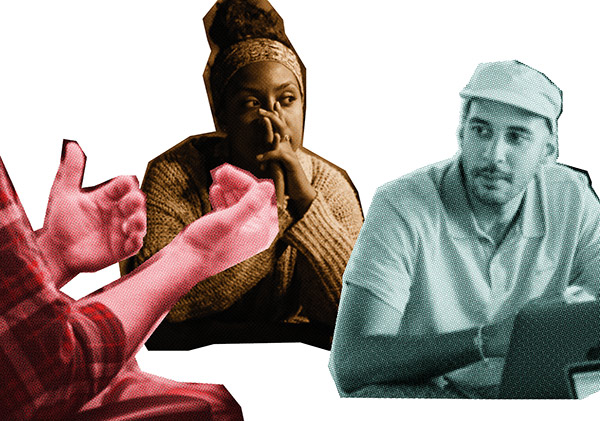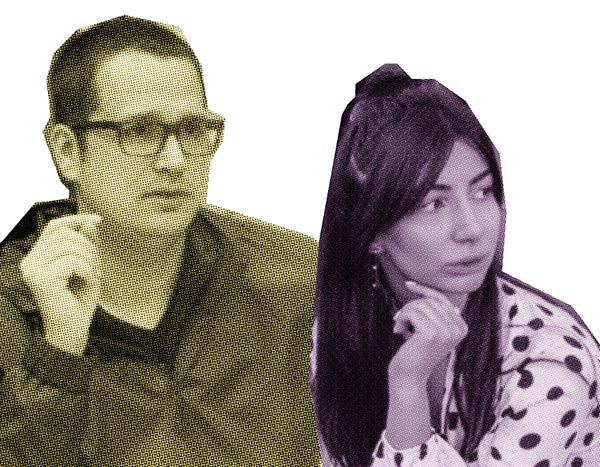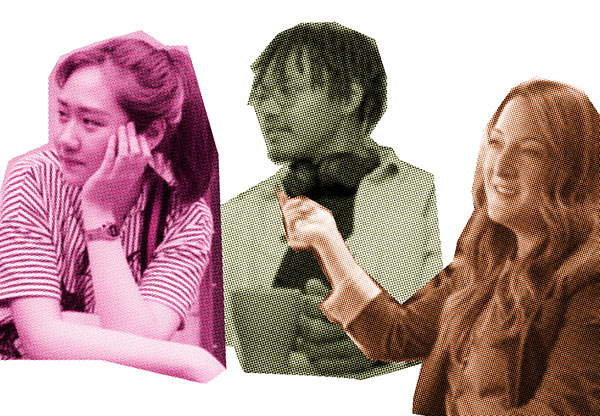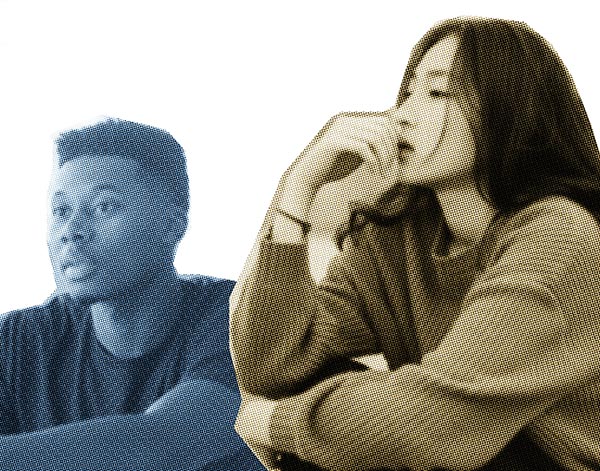Subtotal: $
Checkout-

The Witching Hour
-

Enemy Lovers
-

How God Sees Us
-

Macedonia Morning
-

Tim Keller: New York’s Pastor
-

What Is Time For?
-

Poem: “South Head, a Wild Surmise”
-

Poem: “Lammergeier”
-

Poem: “World Within”
-

When Love Seems Impossible
-

Places to Think with Neighbors
-

Letters from Readers
-

Covering the Cover: The Enemy
-

Thanksgiving Starts in September
-

The Monsignor versus the Fascists
-

Do Activists Need Enemies?
-

The Making of Martyrs
-

Visions of the Kingdom
-

Foolhardy Wisdom
-

Tough Love on the Mount
-

Walls behind Bars
-

My Mind, My Enemy
-

Demining the Sahara
-

Just Doing What Christians Do
-

Hating Sinners

Students Brave the Heat
Conflict can be fruitful when students don’t just debate, but listen to one another.
By Leah Libresco Sargeant
September 19, 2023
Next Article:
Explore Other Articles:
A good enmity looks like this – a circle of chairs under the pallid flicker of fluorescent classroom lights. I worked with the University of North Carolina–Chapel Hill Agora fellows to set up a tight ring initially. If attendance was low, they could still gather closely, with their classmates – their opponents – close enough to touch. But as the door swung open again and again, the circle kept pulsing outward. Spaces were filled, seats scooted back, new chairs were pulled off the stack to fill the gaps.
By the time I pulled my gavel out of my purse and handed off my baby to the sitter, we had a little over forty students ready to try to fight about abortion one more time, but this time, to fight better.
My colleagues and I crisscross the country holding debates on college campuses as part of the Braver Angels Debates and Discourse program. This is our pitch: a space for fruitful conflict, with an equal emphasis on both words. I’m proud of the work we do, but much of the credit belongs to our participants. Plato conceived the role of the teacher as helping students recollect what they already possess, and I think our debates work the same way. We offer a venue where students bring the best of themselves – I’m a midwife, not a ringmaster.
Sometimes, programs centered on dialogue are skittish about allowing sharp disagreement. Their hesitation reinforces to participants that open acknowledgement of conflict is too dangerous to attempt. Debate puts the conflict front and center, so no one needs to worry about making a “mistake” by sparking a real disagreement.

Photographs by Headway, Kevin Turcios, Derek Coleman / Unsplash.
Our format is intended to make that conflict fruitful by offering a transparently fair process. We call on timed speeches, each side getting equal turns. There is no division between speakers and watchers – anyone can participate by speaking or asking a question, and even attendees who do not speak know they have as much access to the floor as anyone else. Everyone is heard, and everyone has to answer questions in good faith.
The debates require attendees to adopt a heightened tone – speakers address each other by surname; people posing questions must rise to ask them; and, finally, questions are directed to the chair, rather than at the speaker. In practice this means that it is forbidden to ask, “How could you say some lives aren’t worth living? Have you ever met the people you’re talking about?” but permissible to say, “Madame Chair, I wonder whether the gentleman thinks that informed consent to an abortion on the basis of disability would require the parents to meet people living with that disability?” This indirect way of asking questions allows speakers to hear clearly that their ideas are being examined, rather than their selves being attacked.
The goal of asking a question is to receive an answer. A hard question is a gift, an invitation to set aside self-protection for the sake of the truth.
It’s tricky to strike the right balance. Questioners may be motivated by a just anger, and we want to leave room for parrhesia – challenging, prophetic speech. But the goal of asking a question is to receive an answer. We want a hard question to be a gift to the speaker, an invitation to set aside self-protection for the sake of the truth.
With each of these rules, we try to make the debate space different from all the prior spaces where one may have fought about this topic. I often start events by asking people to raise their hand if they’ve had a bad conversation on our given topic recently, and then point out that those who raised their hand came to the event motivated by trust and hope – hope that a better conversation is possible, and trust that other people are seeking that too.
In my opening spiel on the rules and their purpose, I always tell the debaters that I can’t guarantee things will go well, but, if nothing else, I want them to go wrong differently than they have before. The debate is meant to be an escape route from the current conversational ruts.
The argument at UNC began long before I arrived on campus. Each of our debates is framed around a specific resolution, and drafting them is tougher than it seems. It’s the part of our formal debate process that tends to get the most pushback. People who are divided from each other know what topic they’re debating, and they often feel like it should be as simple as saying “Gun Control: Yes or No?” “Abortion: Yes or No?” But often, it’s the process of choosing a resolution that begins to reveal how little we know the people who oppose us.
The group organizing the debate tilted pro-choice, so if they wanted to debate the morality of abortion, they would have to recruit pro-life speakers from elsewhere on campus – speakers who were a little reluctant to “out” themselves at a liberal-leaning school. The Agora fellows began by borrowing from the language of political talking points, proposing “Resolved: The government should define life to begin at conception” or “Resolved: Abortion should be illegal after twenty weeks with exceptions for rape, incest, and medical emergencies.”

Photographs by Paul Hanaoka, Ana Itonishvili / Unsplash.
The problem with framing a debate around the possible political compromise of twenty weeks was that it didn’t map well onto what either side wanted. A debate works best when it’s aimed at the heart of what divides the opposing sides. In politics, one might settle for an uncomfortable compromise, but, in the debate, we want students to be able to make the case for what they actually believe. The goal is to offer one’s position as an invitation, an open door for one’s enemy to walk through.
Since the group was struggling to get pro-lifers on their planning committee, we pivoted to consider resolutions that would help speakers explore conflicting values within a pro-choice-leaning group. After some discussion, the group settled on “Resolved: Abortion is justifiable on the basis of expected disability.”
The first speakers were arranged in advance, but there seemed to be one speech made in silence, before the debate formally began. As the chairs were scraped across the floor and rearranged, there was suddenly a still point in the general scuffle. A blind student had entered, one hand on his cane, the other on a classmate’s arm. We cleared a space for him near a gap in the ring, and one student crossed the room to check if he needed anything. Was it helpful to offer a verbal description of the space in which, shortly, we would debate whether his parents should have been able to judge whether it was a mistake to let him occupy space at all?
The first speaker took the floor, glancing briefly at the blind student, and then launched into his planned remarks. He intended to make a case to his fellow pro-choice students as a simple matter of logic. If they, like he, endorsed the slogan “Abortion on demand, and without apology,” how could they object to abortions on the basis of anticipated disability?
Imagine, he said, a woman is going to a clinic for an abortion. Everyone who is pro-choice supports her right to make that choice and also holds that she is the only one who can judge if that choice is right. His fellow pro-choicers think it would be an injustice if someone cross-examined her or asked her to justify her abortion before the procedure. Now, he said, suppose she volunteers the reason, and says the abortion is because of anticipated disability.

Photographs by Trung Thanh, Airfocus, LinkedIn sales solutions / Unsplash.
“How could you flip your position on her abortion upon learning that?” he asked. Especially if you thought women should be able to have abortions simply because they had a right to not be pregnant against their will, how could learning one fact about this fetus have a bearing on that right? Did pro-choice speakers in the negative of the resolution really want to argue that women only had a right to abort completely healthy babies?
It was an excellent opening speech. It’s tempting, both on and off the debate floor, to try to box your enemy in with a flurry of arguments. Debaters who are playing to an audience often use the strategy known as the “Gish gallop” where they raise enough arguments quickly enough that it’s impossible for their opponent to refute them all. What this speaker did was the opposite. He raised one argument, going slowly enough that he could explain why he saw it as pivotal.
As the chair, I had the chance to ask questions myself, and so I embroidered a little on his scenario. Picture the doctor in the procedure room, someone who has built her life around guaranteeing abortion access, someone perfectly willing to perform an abortion in the abstract. She lays out her curette blades, picks up the speculum, and then the woman on the table says, “Thank you, we absolutely didn’t want a girl.” Is the abortion doctor a hypocrite if she puts down her tools and refuses to carry out the abortion?
The speaker paused, genuinely considering the question. In a good debate, the answers often come haltingly, as speakers are jostled a little from what they’ve gone over in their head again and again, and into a bit of ground they haven’t explored. He told me that he hadn’t thought as much about conscience objections in the context of this debate, but he’d have sympathy for a doctor who didn’t want to perform abortions on the basis of sex, particularly if the parents weren’t just trying to balance their family, but had a clear sense of girls as “less-than.” Ultimately, though, he thought that someone should be willing to carry out the procedure – after all, what kind of life potentially awaited the child in a family that didn’t want her?
In a good debate, the answers often come haltingly, as speakers are jostled a little from what they’ve gone over in their head again and again, and into a bit of ground they haven’t explored. The students realize that anyone in the room might be the living embodiment of the hypothetical they are batting around.
The speeches in our debate alternated affirmative and negative, without any further attempt to coordinate on each side. Each speech was too short to cover everything, so speakers focused on a particular facet of the discussion, building up a fuller picture of where and why they differed in the same way that an ultrasound offers blurry, flattened glimpses of the child veiled by the womb.
Flicker-flick: a bright ulna amid shadows, blur-focus: the parents look at the sharp profile and nose, the technician notes the nuchal fold thickness with dismay. Fuzz-resolve: is that a hole in the argument? Is that a hole in the heart?
As the debate went on, the speeches started to revolve around a new question – how clearly could they differentiate between curing a disability and killing the disabled? If a parent faced a threefold choice – to receive the child as is, to intervene in utero and somehow resolve the medical difference, to abort this child and try again – how could the students articulate which choice(s) were permissible?
Down syndrome and Deafness were the examples the students began circling. Can you have a culture that takes pride in a particular difference if it is possible and encouraged to cure it? Does that imply the community around the difference was always a coping mechanism, which should be superseded by a real cure? With a wide gap between how people imagine they’d feel living with a disability versus how disabled people self-report, what does it mean for parents to offer informed consent on behalf of their child?
One student argued that the decision might be hard, but the question of the decider was not. “The mother is the only one who can speak to the interest of the child,” he said. “Only the mother?” one questioner asked, and the speaker admitted he didn’t quite know how to fit in the father. Other students kept prodding at who could speak for the child’s interest – can a Deaf community claim that, by virtue of their shared Deafness, they better know the child’s needs than the child’s parents?
As the students left off speaking about “disability” in the abstract and began debating which specific differences made life not worth living, I noticed more of them glancing at the blind student. One student tried to draw a clearer dividing line between the people present in the room and the implications of the resolution by focusing on whether there is a person in the womb. He asked one speaker in the negative whether she could be making a mistake in extrapolating backward from how we treat disabled adults and children to how we treat fetuses with disability markers. Wasn’t it possible she was extrapolating out of the realm where it was possible to “discriminate” since discrimination presumed choosing among persons?

Photographs by LinkedIn Sales Solutions, and Anthony Tran / Unsplash.
At last a student rose, in the affirmative, for whom the questions we’d been batting about were not abstract. It wasn’t the student with the visible disability, but a quiet boy who hadn’t stood out to me. He spoke of how his family had immigrated to the United States from Saudi Arabia. When his mother next conceived, their finances were shaky. Sickle cell disease ran in his family, and prenatal testing revealed the baby had the trait. In sickle cell disease, blood cells are malformed. Instead of smooth, dimpled disks, they form sickle shapes that can interlock and clot, causing severe, chronic pain and other complications. Sickle cell disease can be treated with drugs and blood transfusions, but it requires vigilance and reliable access to affordable care. For this new immigrant family, it was the uncertainty about whether they could care for their child that led them to choose abortion. His parents hadn’t kept the choice secret from their other children, and he thought they had made the right decision.
A few years later, when they were better established, his mom conceived again, and this time, prenatal testing revealed that the baby had Down syndrome. His parents happily chose to carry their child to term, more confident they were now able to meet a medically complex child’s needs.
After he spoke and answered questions, the students had a sharper sense that anyone in the room might be the living embodiment of the hypothetical they were batting around.
It was then that the blind student rose to speak. He felt many speakers had been too confident that they could assess what disability felt like from the inside. He brought up disability writer Eva Feder Kittay’s distinction between seeking the good life versus a good life. His life is different from a sighted person’s, but it is possible to find a good life. And the narrowness that might cause opposing speakers to miss what “good” could mean in the context of difference and disability might also limit what their own good life could look like.
At the end of the debate, we broke off from the heightened, adversarial format, and held a final debriefing discussion, asking participants to reflect on what they learned and what surprised them. The blind student and the Saudi Arabian student were frequently cited by their classmates for their generosity and trust in laying out their lives before the room, so that people could test their ideas against lived reality. It was more dangerous than abstraction, but it also kept them honest.
Students lingered, chatting with each other, asking more casual follow-up questions about what they’d heard. I had one question of my own. I walked over to the student who had framed his whole speech around evaluating the worth of a life through a utilitarian calculus of Quality Adjusted Life Years. He’d glanced a couple times at written notes, which I couldn’t help but notice he’d been taking with his paper braced against Aristotle’s Nichomachean Ethics for support.
He was clearly a noted and somewhat affectionately received campus provocateur. He’d come out swinging on the floor, in favor both of abortion in the cases of some disability, but also of “curing” some differences, like autism and Deafness, if it was clear enough (as he felt it was) that those differences led to worse quality of life. This had sparked a question about whether he’d submit to a similar cure, if one were found for his cheerful belligerence.
Did the book buzz in protest, I asked him, when you used a treatise on virtue ethics to write down such bluntly consequentialist points? He laughed, and pulled it out from his bag. “I borrowed this from my anti-vax, environmentalist friend!” As he and his classmates streamed out, they carried less visible signs of cross-pollination and gifts received from ostensible enemies.
Already a subscriber? Sign in
Try 3 months of unlimited access. Start your FREE TRIAL today. Cancel anytime.





































Michael Nacrelli
I know this is totally beside the point of the article, but I have to ask why "Deafness" is arbitrarily capitalized among all the other disabilities mentioned. On a more substantive level, I wish someone had challenged the bodily autonomy absolutism of the first speaker. The Equal Rights Institute has done some great work in this regard. Their outreach efforts on college campuses are very impressive.
Dominic Palmer
I appreciated reading this detailed account of educational courage from all involved. Having been a high school English teacher for several years, I understand how challenging it can be to cultivate a classroom environment that is curious and amicable rather than adversarial. I feel especially moved by those students who come into a lesson already 'armed for conflict', often for complex reasons outside their control. I think of one boy who I began teaching when he was 14. He had been out of education for over a year when he arrived, and became homeless more than once during his two years in my class. We got off to a rocky start: his insecurities expressed themselves as apathy and defiance, mine as aloofness and roboticism. But a turning point came during a lesson on Tennyson's "The Charge of the Light Brigade". After a bit of military history, I did a couple of tricks with a nearby plastic sword to illustrate the "sabres" in the poem. At the end of the explanation I heard a quiet, "Sir...can you show me how to do that?" What an opportunity! I did, of course. After that, I found I no longer had to go into those lessons praying for grace to love my enemy. That moment of curiosity and vulnerability (especially on my student's part - the teacher was doing something worth imitating?!) turned us into educational allies. Of course it wasn't all straightforward from there, but we were no longer at loggerheads. Instead we stood, as we had with our plastic swords, shoulder to shoulder. Dominic Palmer, Manchester, UK
John Wilson, Jr.
This article made me think of an article written a number of years ago in the journal “Tablet” (a journal devoted to Jewish topics) by Leon Wieseltier. It was called “The Argumentative Jew” and it discussed the importance of disagreement and debate between those that want the best for their faith (in this case Talmud and Judaism). The disagreements are important if we are to live together and wend our way through our different priorities and core beliefs: “Learning to live with disagreement, moreover, is a way of learning to live with each other. Etymologically, the term machloket refers to separation and division, but the culture of machloket is not in itself separatist and divisive. This is in part because all the parties to any particular disagreement share certain metaphysical and historical assumptions about the foundations of their identity. But beyond those general axioms, the really remarkable feature of the Jewish tradition of machloket is that it is itself a basis for community. The community of contention, the contentious community, is not as paradoxical as it may seem. The parties to a disagreement are members of the disagreement; they belong to the group that wrestles together with the same perplexity, and they wrestle together for the sake of the larger community to which they all belong, the community that needs to know how Jews should behave and live. A quarrel is evidence of coexistence. The rabbinical tradition is full of rival authorities and rival schools—it owes a lot of its excitement to those grand and even bitter altercations—but the rivalries play themselves out within the unified framework of the shared search. There is dissent without dissension, and yet things change. Intellectual discord, if it is practiced with methodological integrity, is compatible with social peace.” I think Wieseltier’s thoughts are true with any community, like the body of Christ, that must struggle with a diversity of views. When it comes to the abortion issue, for example, I am pro-life, but how I understand pro-life is not how many evangelicals define pro-life. There is overlap, but there are also profound differences. We have to be able to talk through these differences without breaking the community.
Ben Kercheval
Thank you for this heartening illustration of what the debate on abortion can look like.